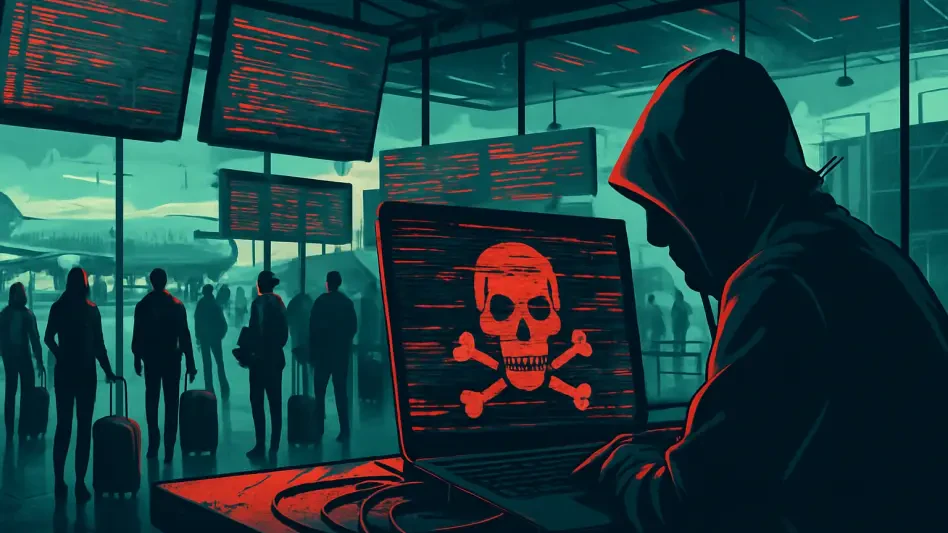Imagine boarding a flight at one of Europe’s busiest airports, only to find check-in systems down, lines stretching endlessly, and staff scrambling with handwritten baggage tags, creating a chaotic scene for millions of travelers. On September 20, a sophisticated cyberattack struck major hubs like London’s Heathrow, Brussels Airport, and Berlin’s Brandenburg Airport, targeting Collins Aerospace’s MUSE software—a critical tool for check-in and boarding processes—causing widespread delays and cancellations, and exposing vulnerabilities in aviation infrastructure. This roundup gathers diverse opinions, expert analyses, and practical tips from industry voices to unpack the incident’s impact, dissect the security gaps, and explore how the aviation sector can better shield itself from digital threats.
Unpacking the Disruption: What Happened and Why It Matters
The scale of the cyberattack was staggering, affecting multiple high-traffic airports simultaneously and disrupting electronic check-in and baggage drop systems. Reports indicate that Heathrow faced 201 delays and 10 cancellations, while Brussels saw 139 delays and 7 cancellations on that chaotic day. The reliance on a shared third-party platform amplified the fallout, as manual workarounds struggled to keep pace with modern travel demands. This event underscored a harsh truth: aviation’s digital backbone, while efficient, can become a single point of failure when targeted by malicious actors.
Industry observers have noted that such coordinated strikes are becoming more common, signaling a shift in how cyber threats impact critical infrastructure. The attack wasn’t just a technical glitch; it was a systemic wake-up call. Many stakeholders pointed out that the aviation sector’s push for interconnected technology, while innovative, often outpaces the development of robust security measures. This incident has sparked a broader conversation about balancing efficiency with resilience in an era of escalating digital risks.
Voices from the Field: Diverse Perspectives on the Cyber Strike
Passenger Frustrations and Real-World Impact
Travelers caught in the chaos painted a grim picture of long wait times and operational bottlenecks. At Heathrow, passengers described the frustration of manual processes, with one account highlighting the absurdity of handwritten baggage tags in a supposedly high-tech environment. Airport advisories, such as limiting arrival windows to manage crowds, only added to the confusion for those already facing delayed or canceled flights.
Feedback from affected individuals also revealed a deeper concern: trust in airport reliability. Many expressed dissatisfaction with the lack of timely updates or clear communication during the crisis. This sentiment suggests that beyond technical fixes, airports and airlines must prioritize transparent engagement with passengers to mitigate reputational damage during such disruptions.
A recurring theme among traveler opinions is the need for contingency plans that don’t leave people stranded for hours. Some suggested that airports should have pre-trained staff for manual operations to ensure smoother transitions during system failures. These firsthand accounts emphasize that the human toll of digital breakdowns often overshadows the technical aspects, urging a more people-centric response to future incidents.
Industry Experts Weigh In on Security Gaps
Cybersecurity professionals have been vocal about the attack’s sophistication, particularly its exploitation of supply chain vulnerabilities through a shared software platform. Many in the field described the incident as a stark reminder that third-party systems, often assumed secure, can become gateways for widespread disruption. This perspective calls for a reevaluation of how aviation stakeholders assess and monitor external vendors.
Another viewpoint from technology analysts focuses on the intent behind the attack, with some leaning toward classifying it as vandalism rather than a financially motivated scheme. While the motive remains unclear due to limited public data, this uncertainty has fueled discussions about the need for better intelligence-sharing within the industry. Experts argue that understanding attack patterns could help preempt similar strikes in the future.
There’s also a consensus among security specialists that current defenses lag behind the evolving nature of cyber threats. Recommendations include adopting multi-layered protection strategies and conducting regular stress tests on critical systems. These insights highlight a pressing demand for the aviation sector to shift from reactive measures to proactive fortifications against digital adversaries.
Airport and Airline Responses: A Mixed Bag
Feedback from airport management reveals a spectrum of preparedness levels during the crisis. Some hubs, like Heathrow, issued public statements acknowledging potential delays and urging patience, yet offered little detail on the root cause or long-term fixes. This lack of transparency has drawn criticism from industry watchers who believe candid communication could rebuild trust more effectively.
Airlines, on the other hand, showed varying degrees of resilience. Certain carriers with established backup systems managed to maintain near-normal operations, while others grappled with significant bottlenecks. This disparity has led to calls for standardized contingency protocols across the board, ensuring no single entity is disproportionately affected by such disruptions.
Operational leaders in the aviation space have also pointed out that while manual fallbacks prevented total shutdowns, they are unsustainable for high-volume environments. Suggestions include investing in hybrid systems that blend digital and analog processes for seamless transitions during crises. These observations underscore the need for a unified approach to recovery planning among all aviation stakeholders.
Practical Tips for Travelers and Industry Players
Amid the chaos, travel advisors have compiled actionable advice for passengers navigating potential disruptions. Staying updated via airport social media channels or official apps can provide real-time information on delays or procedural changes. Additionally, arriving within recommended time windows, as advised during the incident, can help avoid unnecessary congestion in terminals.
For those in the aviation industry, the incident has prompted recommendations to diversify software dependencies and reduce reliance on single third-party platforms. Conducting frequent cybersecurity audits and fostering partnerships with tech security firms are also seen as critical steps. These tips aim to build a more robust framework that can withstand unexpected digital assaults.
Another practical takeaway is the importance of passenger communication strategies. Airlines and airports are encouraged to develop clear, multi-channel messaging systems to keep travelers informed during crises. Combining these efforts with enhanced training for staff on manual operations could significantly lessen the impact of future system failures on day-to-day travel.
Key Takeaways from the Aviation Cyber Crisis
Reflecting on the insights gathered, several main points emerged from this tumultuous event. The cyberattack exposed critical weaknesses in aviation’s digital infrastructure, particularly in supply chain dependencies that left multiple airports vulnerable. Passenger experiences highlighted the inefficiencies of manual fallbacks, while expert analyses pointed to the sophistication of modern cyber threats and the urgent need for upgraded defenses.
Differing views on transparency and preparedness also surfaced, with some stakeholders advocating for open dialogue about security gaps, while others focused on immediate operational recovery. Despite these variances, a shared recognition of the need for systemic change was evident. The incident served as a catalyst for rethinking how technology and security intersect in high-stakes environments like international airports.
Looking back, the September 20 cyberattack was a defining moment that challenged the aviation industry to adapt. Moving forward, actionable steps include investing in resilient backup systems, enhancing cybersecurity protocols, and fostering greater collaboration among airports, airlines, and software providers. These efforts, combined with a commitment to passenger-centric communication, offer a path toward preventing similar crises and ensuring safer, more reliable travel experiences for all.








